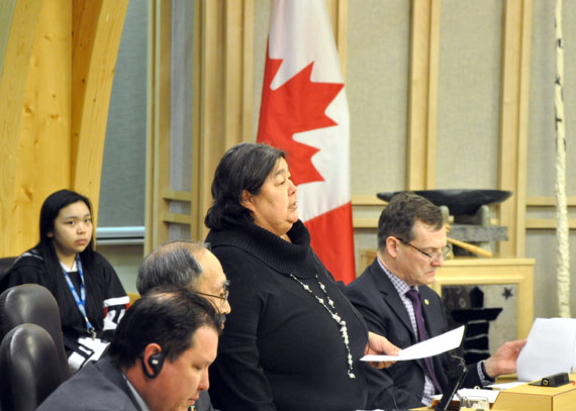Nunavut minister says federal trade corridors fund might help pay for territory’s transport dreams
Nunavut has pinned its hopes on getting money from a pot of cash controlled by federal government called the National Trade Corridors Fund to pay for its “longstanding transportation priorities,” Monica Ell-Kanayuk, the Nunavut minister of economic development and transportation, said Sept. 14.

Projects submitted earlier this month to the federal government’s $400-million, 11-year program, announced last month, include the Grays Bay road and port, the Nunavut-Manitoba winter road, air terminal building replacements in Naujaat, Chesterfield Inlet, Whale Cove, Kugluktuk and Kimmirut, marine infrastructure for Qikiqtarjuaq and Rankin Inlet, and airport relocations in Pangnirtung and Kimmirut.
Ell-Kanayuk said that the Government of Nunavut’s “expression of interest” for support under Grays Bay under the National Trade Corridors Fund had been accepted.
“This means that now we have to put a business case forward and, at this time, that does not mean that there are funds attached to it,” Ell-Kanayuk said in the Nunavut Legislature.
But she added that GN plans to spend $2 million on the Nunavut Impact Review Board process for Grays Bay and “make this project ready for consideration.”
In the first phase of Grays Bay, the GN and its partner, the Kitikmeot Inuit Association, would build a deepwater port in western Nunavut at Coronation Gulf on the Arctic Ocean and a 230-kilometer (about 140-mile) all-season road between the port and the site of the abandoned Jericho diamond mine.
From Jericho, the all-season road would hook up with the Tibbitt-Contwoyto winter road, which offers a seasonal cold-weather route to Yellowknife.
The second phase would see a 95-kilometer (about 60-mile) all-season road run from Jericho to the Northwest Territories border, where it would hook up with an all-season road to Yellowknife which the Government of the NWT wants to build in the future.
As for the Nunavut-Manitoba winter road, judging from correspondence tabled in the legislature Sept. 14, the GN also wants to get this this road project under the trade corridor fund umbrella.
The road, as now proposed, would end near Tadoule Lake in northern Manitoba, and connect to the existing Manitoba winter road network— instead of to Churchill, whose railway link to the South needs a big overhaul after suffering damage this past spring.
Tadoule Lake lies about 600 kilometers (about 370 miles) south of central Nunavut’s transportation hub, Rankin Inlet.
“The winter road would be a boon to your northern economy. It would help facilitate the growing commerce between Winnipeg and our Kivalliq region,” Premier Peter Taptuna wrote Manitoba Premier Brian Pallister in August, in a letter tabled Sept. 14 in the legislature.
Taptuna’s letter, written in August. seeks support from Pallister for the Manitoba-Nunavut road.
“It will provide the only transportation corridor from Nunavut to the rest of Canada and it will create seasonal employment and business opportunities for business and northerners in Manitoba and Nunavut,” Taptuna said.
The other projects sent by the GN to Ottawa for consideration under the National Trade Corridors Fund include the relocation of Pangnirtung’s airport, located in the middle of the community of about 1,500—and, whose landing strip, at less than 900 meters (about 2,950 feet), limits the types of aircraft that can land there and is too short for landing with a full load—and of Kimmirut’s airport, which at 579 meters (about 1,900 feet), is the second shortest in Nunavut.